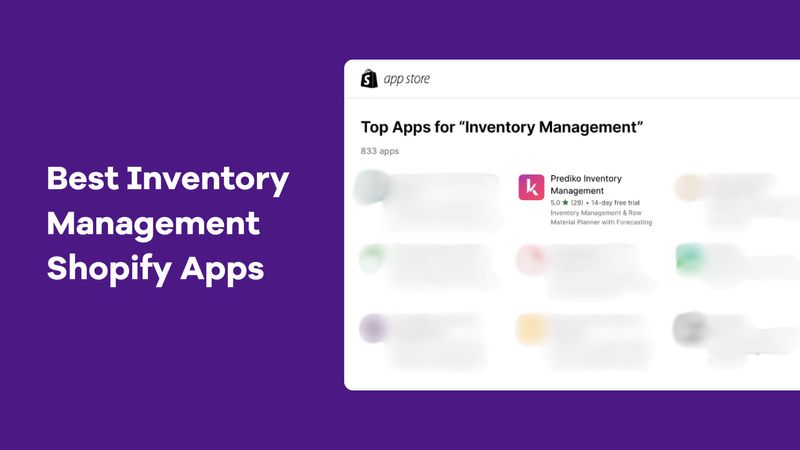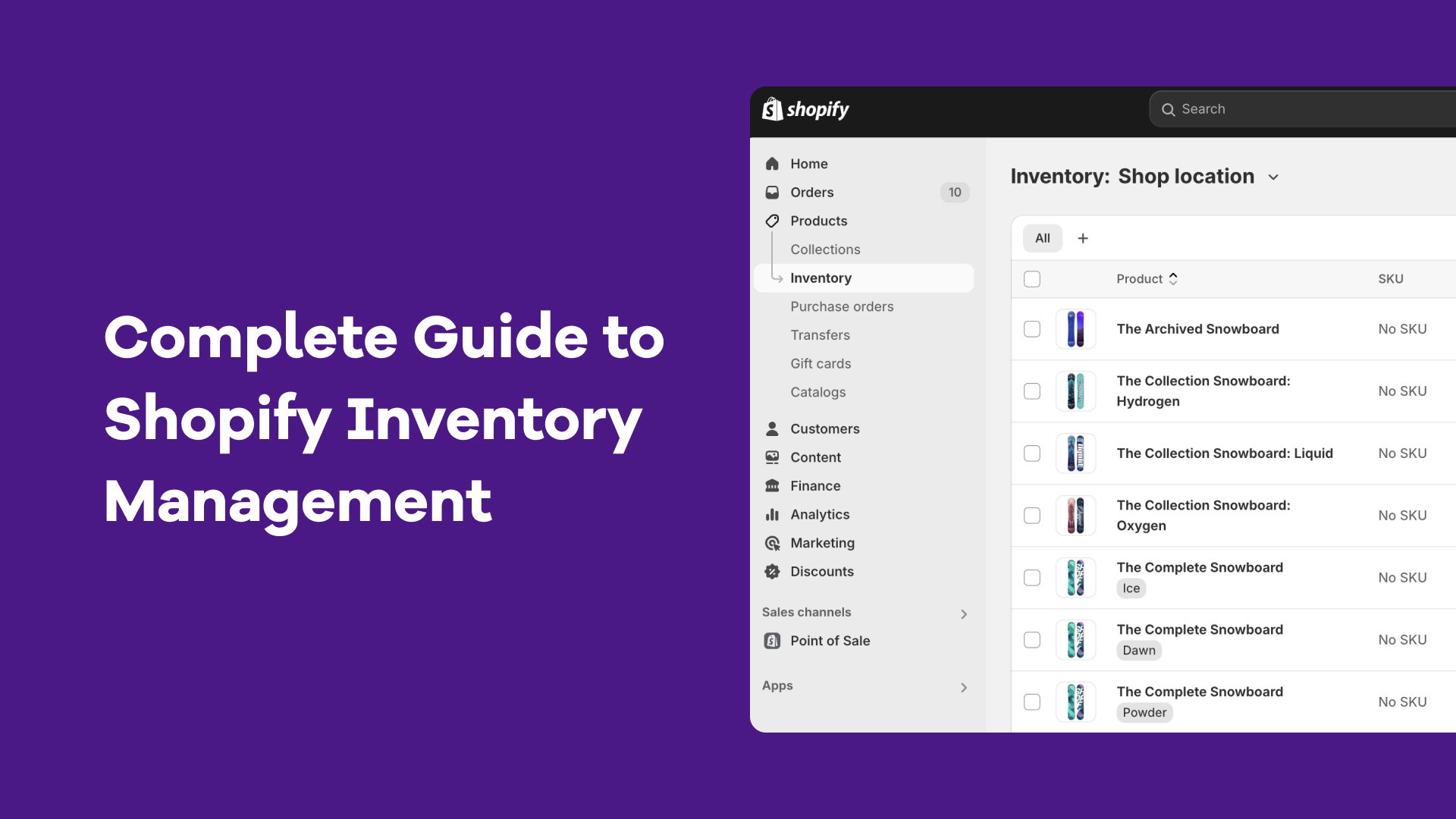5 Practical Inventory Tracking Spreadsheet Templates for Shopify Brands
If you’re not ready to invest in a full-fledged inventory management system just yet, spreadsheets can still help.
We’ve created 5 free inventory tracking spreadsheet templates for Shopify brands so that you stay organized and make smarter inventory decisions, without the overwhelm.
1. Basic inventory tracking spreadsheet
Tl;DR: This template is ideal for low-SKU Shopify sellers tracking inventory manually with reorder point automation
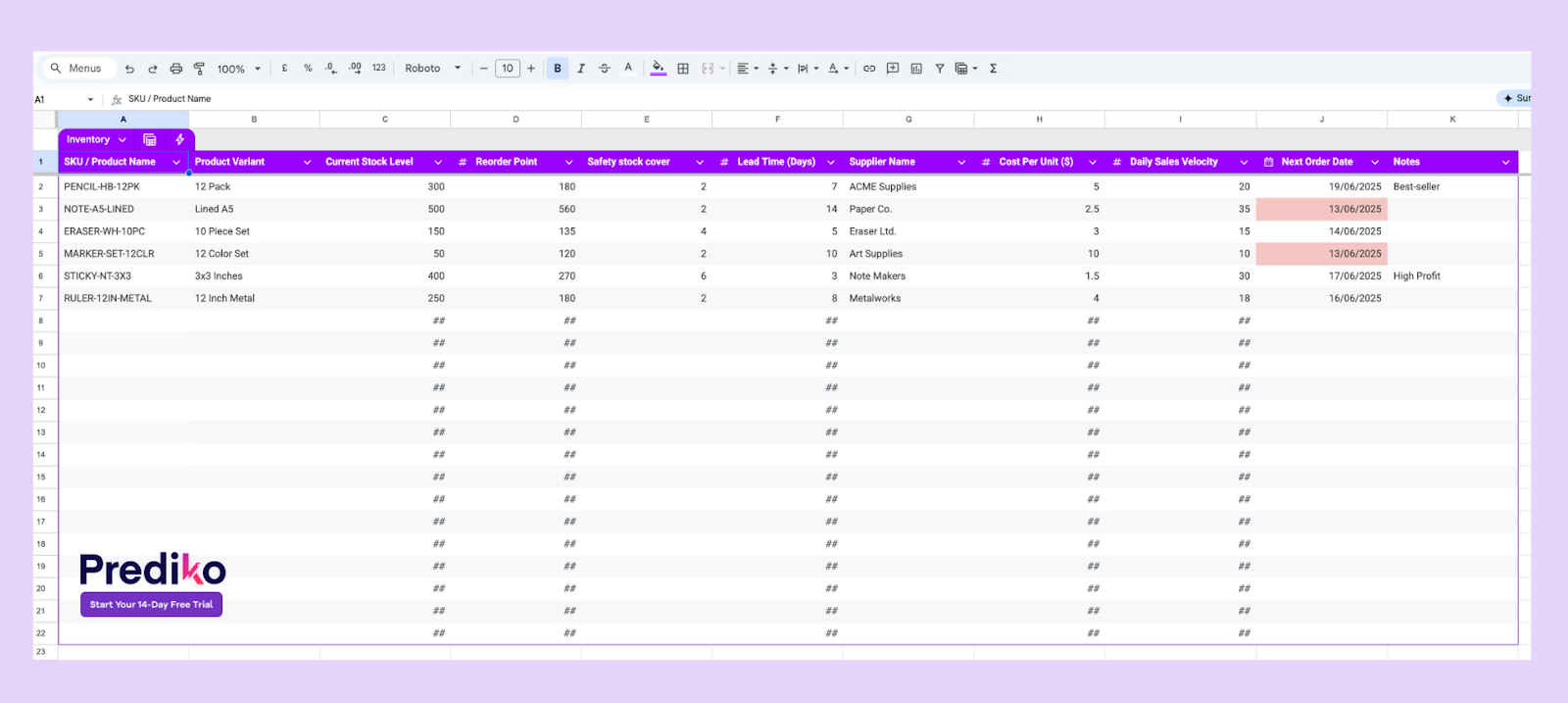
Download basic inventory tracking spreadsheet
This inventory tracking spreadsheet is designed especially for Shopify brands looking for a straightforward way to manage and reorder their stock.
In this template, you just need to enter your current stock, daily sales velocity, supplier lead times, and safety stock, and the sheet automatically calculates when you need to reorder (your reorder point) and the ideal reorder date.
2. Raw materials inventory tracking spreadsheet
Tl;DR: Perfect for Shopify brands managing in-house production and raw materials reordering based on output plans

Download raw materials inventory tracking spreadsheet
This spreadsheet is designed specifically for Shopify manufacturers and in-house production brands.
It calculates how much raw material you need to reorder based on your production plan and current stock levels.
It also gives you the total cost of goods manufactured (COGM) based on planned output, so you can track inventory needs and costs in one place.
3. Inventory planning spreadsheet
Tl;DR: Designed for Shopify brands needing to compare sales plans vs. actuals and analyze YoY growth trends.

Download inventory planning spreadsheet
This inventory tracker template helps you track monthly sales and quantities against your plan and last year’s performance.
It includes formulas to calculate year-over-year (YoY) growth for both sales and units, comparing planned and actuals side by side, so you can quickly identify trends, gaps, and performance against forecasts.
Learn which forecasting models in Excel give you the most accurate results (and how to set them up step by step).
4. Purchase order tracking spreadsheet
Tl;DR: Ideal for sellers wanting clear visibility into every PO’s status from order to delivery and payment.
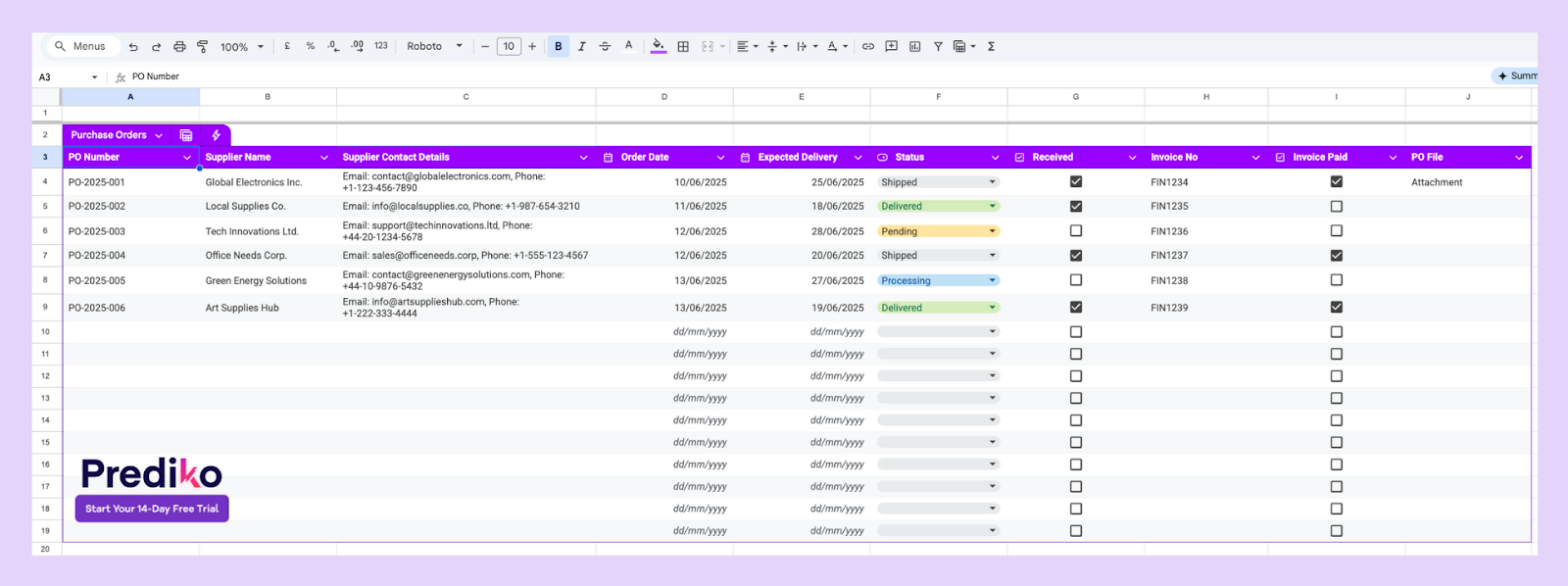
Download purchase order tracking spreadsheet
This inventory tracker in Excel helps you track every purchase order from issue to delivery. You can input key details like supplier info, order and delivery dates, status, and invoice numbers.
This helps you quickly see which POs are pending, shipped, or delivered and whether the goods have been received and paid for.
5. Warehouse Inventory Tracking Spreadsheet
Tl;DR: Best for Shopify businesses managing multiple warehouse locations and auditing stock movement regularly.
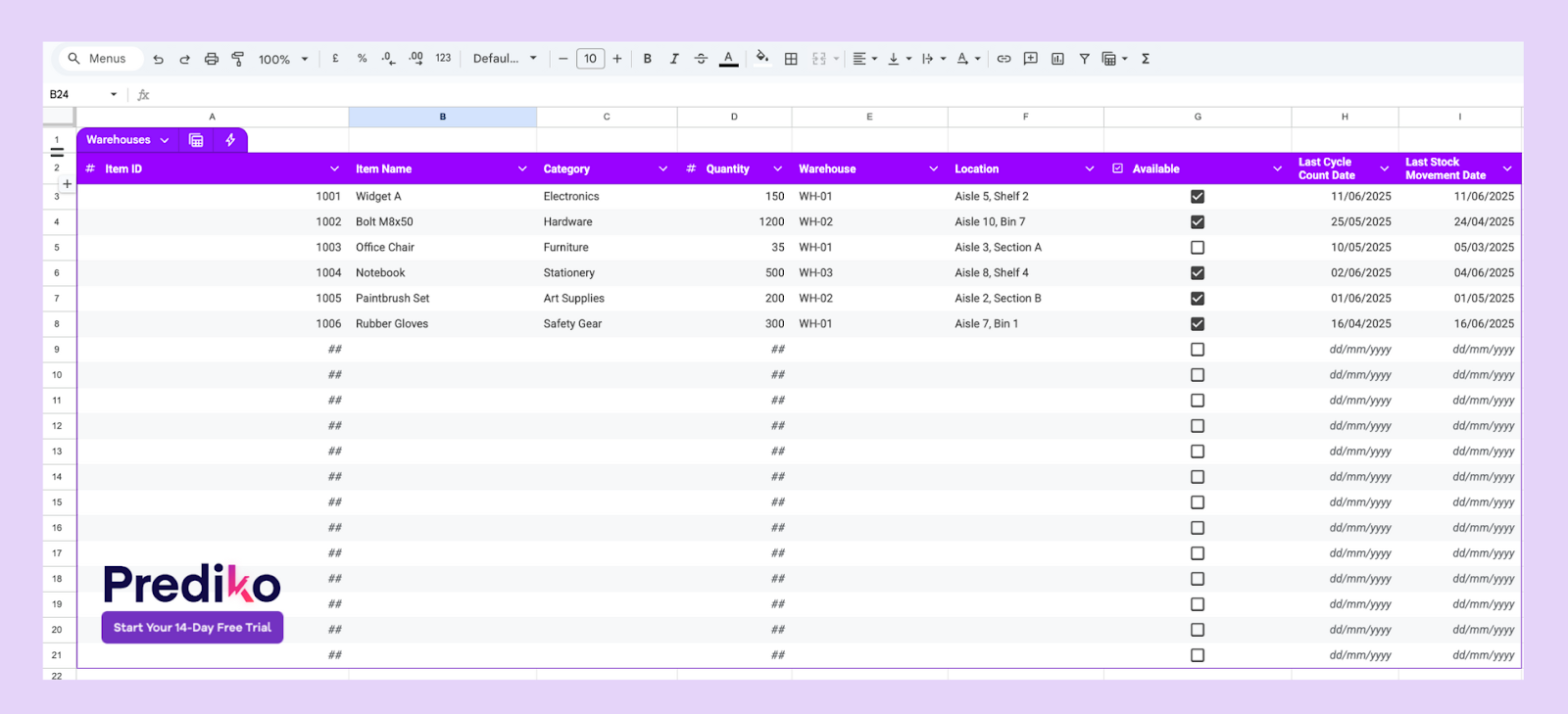
Download warehouse inventory tracking spreadsheet
This sheet's inventory tracking template helps you stay on top of stock across different warehouse locations.
It lets you record item details, categories, quantities, and where each product is stored. You can also log the last stock movement and cycle count dates to keep a basic inventory audit template and spot slow-moving items.
Looking for an automated tool to track your inventory? Explore the best inventory tracking apps for Shopify.
How to Build an Inventory Tracking Spreadsheet (Step-by-Step)
To make the inventory tracker Google Sheets or spreadsheets work for your Shopify store, you need to set them up the right way from the start.
A well-structured spreadsheet can give you better visibility and control. You can build one by following these simple steps.
Step 1: Set up your columns
The first step is to structure your spreadsheet with the right columns. Each row will represent a product or variant (e.g., size, color), and each column should track a specific attribute or metric.
Common columns of a basic inventory tracking spreadsheet include
- SKU / product name: The unique identifier for each item
- Product variant: Size, color, or other differentiator
- Current stock level: How much you currently have on hand
- Reorder point: The minimum quantity before reordering
- Lead time (in days): How long it takes from placing a PO to receiving stock
- Supplier name or details: Who you’re buying it from
- Cost per unit: Helps with COGS tracking
- Sales velocity: Units sold per week or month
- Next order date: When you should reorder
- Notes: Add any special context or tags
Tip: Format your inventory tracking sheet well by bolding headers, freezing the top row, and using filters to easily sort or search. This makes it much easier to look through the data and find what you need.
Step 2: Add formulas for calculations
Automate whatever you can with formulas. This reduces manual work and helps avoid errors.
Key formulas to consider
- Stock Status: Use conditional formatting to highlight low stock
Formula: =IF([Current Stock]<[Reorder Point], "Reorder", "OK")
- Forecasted Stockout Date: See how many days/weeks are left before a stockout
Formula: =[Current Stock]/[Sales Velocity]
- Recommended Reorder Quantity: Easily figure out when you should place the next PO
Formula: =([Sales Velocity] x [Lead Time]) + Safety Stock - Current Stock
Create your own custom formulas based on what matters most to you, whether it's identifying overstock, aging inventory, or dead stock.
Tip: Use data validation to create drop downs (e.g., supplier names or categories). This helps standardize entries and reduce input errors across your sheet.
Step 3: Update regularly
Spreadsheets for tracking inventory are only useful if they’re accurate. Set a clear update cadence depending on your order volume.
- Low volume stores: Update once a week
- Mid to high volume: Update daily or after major orders or sales runs
- Team collaboration: Assign ownership; who updates what, and when
Consider using Shopify’s product export feature to pull current inventory into your spreadsheet and compare it against your manual records.
To make things easier, you can add a column, called "Last Updated" to your sheet and manually enter the date each time you update a row (e.g., 06/09/2025).
For monitoring outdated rows, add another column, say K, called "Update Status" and use this formula: =IF(K2<TODAY()-7, "Update Needed", "Current")
This will flag any product row that hasn’t been updated in the last 7 days, helping you stay on top of stale data.
Step 4: Include basic charts for better visibility (optional)

Visuals help you spot trends faster, like slow-moving SKUs or looming stockouts.
Suggested charts include
- Stock levels by SKU: Bar charts showing which items are available in what quantities
- Sell-through rate over time: Line graph comparing sales vs stock
- Top 10 fastest-moving products: Helps prioritize reordering
- Low stock alerts by category: Pie chart showing which product categories have the most SKUs nearing their reorder point
Use Google Sheets’ or Excel’s built-in charting tools and connect them to your data with pivot tables if needed.
This step-by-step approach gives you a more intelligent spreadsheet, not just a table, but a tool.
Running an apparel brand on Shopify? This article includes a free inventory management template plus actionable inventory tips.
And when you're ready to move beyond spreadsheets, tools like Prediko can automate all of this (and more) without the manual work.
Pros and Cons of Using Inventory Tracking Spreadsheets
Before relying too heavily on inventory tracking Google Sheets, it’s important to evaluate whether they still meet your business needs, or if it’s time to move to something more advanced. Here’s a breakdown of the pros and cons to help you decide.
Pros
- Familiar interface, no learning curve: Most teams already know how to use Excel or Google Sheets; no onboarding or learning curve required
- Highly customizable: You can build it your way. Add fields, formulas, and tabs to match your workflow
- Quick to share and collaborate: It’s easy to loop in teammates, suppliers, or accountants via the cloud access
- Low-risk trial tool: Great for testing out processes before investing in inventory software
Cons
- Manual data entry: A single typo or incorrect formula can throw off your entire inventory count, leading to bad decisions
- No real-time updates: What’s in your spreadsheet may not reflect what’s actually in stock right now, as you need to update stock levels manually
- Hard to scale: More SKUs and channels lead to more chaos. Spreadsheets become harder to manage and maintain.
- Limited visibility: It’s tough to get a clear picture of inventory across locations, suppliers, or warehouses without a centralized system
- Version control issues: Different departments may be working with different spreadsheets. It’s easy to lose track of what’s accurate.
What is an Inventory Tracking Spreadsheet?
An inventory tracking spreadsheet is a simple, manual tool that is used to monitor all things related to inventory —be it stock levels, sales, raw materials, or purchase orders.
It is usually created and maintained in Excel or Google Sheets. For early-stage brands or lean teams, it's often the go-to starting point.
You can add and update SKUs, record supplier information, and even build basic reorder formulas, all within the spreadsheets.
1. Basic inventory tracking spreadsheet
What it is
A simple inventory tracking spreadsheet built for Shopify brands to manage and reorder stock with ease. Input your current stock, daily sales velocity, lead times, and safety stock, then it calculates your reorder point and ideal reorder date automatically.
When to use
Use this if you need a fast, no-frills way to monitor your inventory and know exactly when to reorder, without using any software.
Download basic inventory tracking spreadsheet
2. Raw materials inventory tracking spreadsheet
What it is
Made for Shopify manufacturers and in-house production brands, this spreadsheet calculates how much raw material you need based on your production plan and current inventory. It also calculates your cost of goods manufactured (COGM).
When to use
Perfect for brands producing in-house or working with raw materials who want to connect material inputs to production output and costs.
Download raw materials inventory tracking spreadsheet
3. Inventory planning spreadsheet
What it is
This inventory tracker template helps track your monthly sales and units against your plan and last year’s numbers. It includes formulas to calculate year-over-year (YoY) growth and compare planned vs. actuals side by side.
When to use
Ideal for teams who want to monitor inventory performance over time, spot trends, and improve forecast accuracy using Excel.
Download inventory planning spreadsheet
Learn which forecasting models in Excel give you the most accurate results (and how to set them up step by step).
4. Purchase order tracking spreadsheet
What it is
This inventory tracker in Excel lets you log and monitor every purchase order, from supplier details to order status, delivery timelines, and invoice numbers.
When to use
Use this to manage and track your PO lifecycle from issue to payment, ensuring nothing falls through the cracks.
Download purchase order tracking spreadsheet
5. Warehouse inventory tracking spreadsheet
What it is
This sheet helps you manage stock across different warehouse locations. Track item details, quantities, storage locations, stock movements, and cycle count dates..
When to use
Best for businesses managing multiple storage points and looking for a simple way to track physical stock and maintain audit readiness.
Download warehouse inventory tracking spreadsheet
Looking for an automated tool to track your inventory? Explore the best inventory tracking apps for Shopify.
When to Move Beyond Inventory Tracking Spreadsheets
When using inventory tracking Excel sheets, there comes a time when they become more of a blocker than a helpful tool.
Recognizing these warning signs early can save you from costly mistakes and operational headaches. These include
1. You’re spending too much time updating the sheet
Manually updating a spreadsheet becomes time-consuming as your Shopify store grows.
If you’re dedicating more than 30 minutes every day to the following tasks, it’s a sign that spreadsheets are slowing you down and you're ready for dedicated inventory management software.
- Exporting Shopify inventory CSVs
- Entering and cross-checking sales and inventory data
- Fixing formula errors
- Verifying stock counts
- Training new teammates to work on your complex spreadsheet
2. You often experience stockouts or overstocking
Spreadsheets rely on manual data entry and basic formulas that can't account for complex demand variables, leading to two expensive problems: stockouts and overstocking.
Signs to look out for include frequent stockouts on predictable products, customers asking about restock dates, emergency high-cost orders, and having more than 90 days of non-seasonal inventory tied up in storage.
Struggling with frequent stockouts? Then this guide is for you.
3. You manage more than one warehouse or sales channel
Managing inventory across multiple locations with spreadsheets becomes complex fast. Each new location or store multiplies the data you manage and the error potential.
This complicates stock tracking, fulfillment, and reporting. You face issues like shipping from the wrong warehouse, inaccurate stock levels, and difficulties tracking transfers or returns.
When you’re juggling tabs for each location, writing complex formulas to stitch data together, and making decisions with incomplete information, it’s a clear sign you’ve outgrown spreadsheets.
4. Your team is growing, and the spreadsheet’s getting messy, making data unreliable
As your team expands, a shared spreadsheet becomes a source of chaos rather than insights, leading to inaccurate data and unreliable inventory tracking.
Warning signs you've hit this point include
- Your team has 3+ members editing the same spreadsheet, causing frequent errors like duplicate SKUs or incorrect stock counts
- You're spending valuable time resolving conflicts and tracking down who made which changes
- Data discrepancies are leading to costly ordering mistakes, such as purchasing excess stock for discontinued products or missing reorders for bestsellers
Want to Try a Smarter Solution Than Spreadsheets? Switch to Prediko
If you’ve used any of the spreadsheets above (or built your own), you already know how exhausting it gets. Manually updating stock levels, chasing down errors, and stitching together numbers from multiple tabs can drain the life out of your workflow.
An inventory tracking system in Excel only works up to a point when you have
- 10-15 SKUs
- 1-2 warehouses or stores
- A single person handling inventory
- Minimal supplier complexity
- No real urgency around reordering or accuracy
But once you start scaling—more products, more locations, more people—things fall apart fast. Errors creep in, visibility drops, and decision-making slows down.
Each of the templates above covers a different piece of the supply chain. However, juggling all these different aspects manually isn’t scalable. Prediko replaces all of this.
Prediko brings everything together in one clean, AI-powered UI, so you’re not constantly switching tabs, second-guessing numbers, or reacting too late.
Take Healf, a UK-based retailer, for example. They moved from spreadsheets to Prediko and cut stockouts from 4% to 1% in just two months. The app also brought them 75x ROI and saved 10+ hours each week on inventory tasks. Read more here.
Here’s how Prediko delivers outcomes like this
1. Real-time sync with Shopify
.png)
Prediko syncs with Shopify in real-time, automatically updating stock levels across all your stores and warehouses.
It eliminates manual data entry and reduces the risk of human error, giving you accurate, up-to-date visibility at all times.
2. AI-demand and supply planning
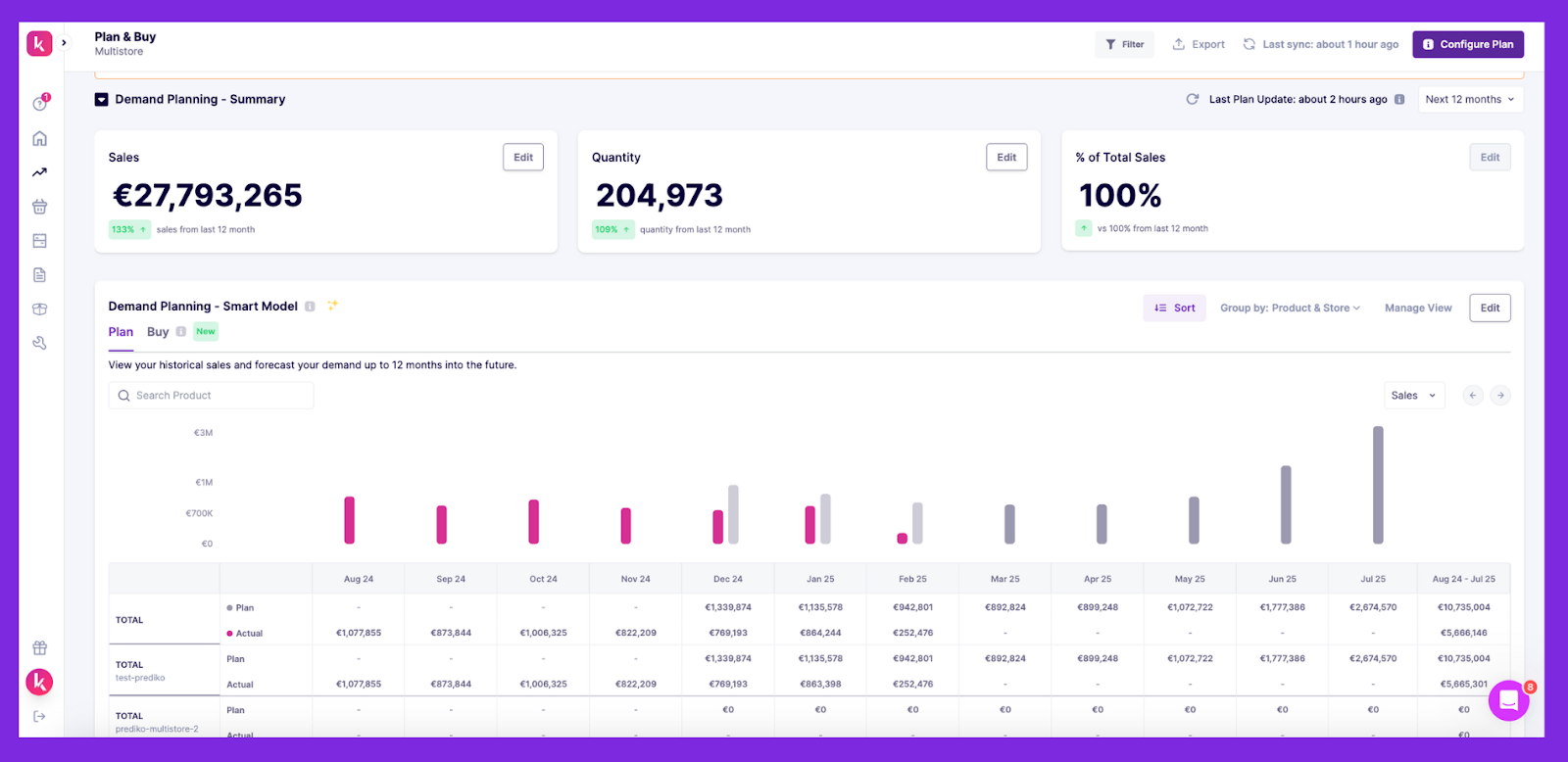
Prediko’s AI is trained on 25 million SKUs across 15 industries. It analyzes your historical data to identify seasonality, trends, and growth patterns, then generates accurate, editable forecasts that balance automation with human judgment.
You get a AI-powered buying plan right alongside your forecast, which suggests what you should order, when, and in what quantities.
3. Purchase order management
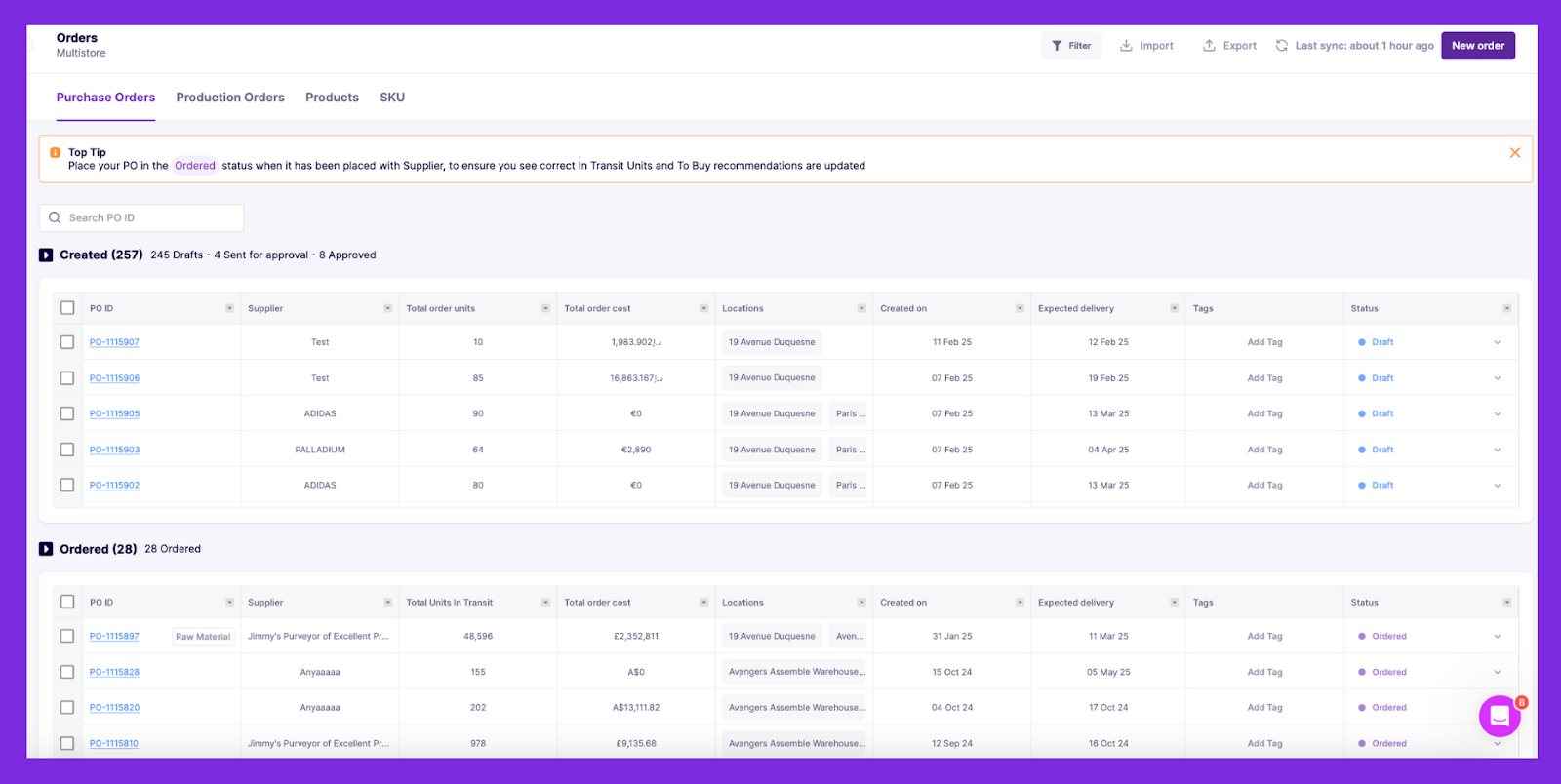
Create, track, and manage purchase orders directly within Prediko; no switching between tools.
Share POs with suppliers, track order costs, quantities, delivery locations, and statuses in one place, without needing extra spreadsheets or calculations.
4. Raw materials management
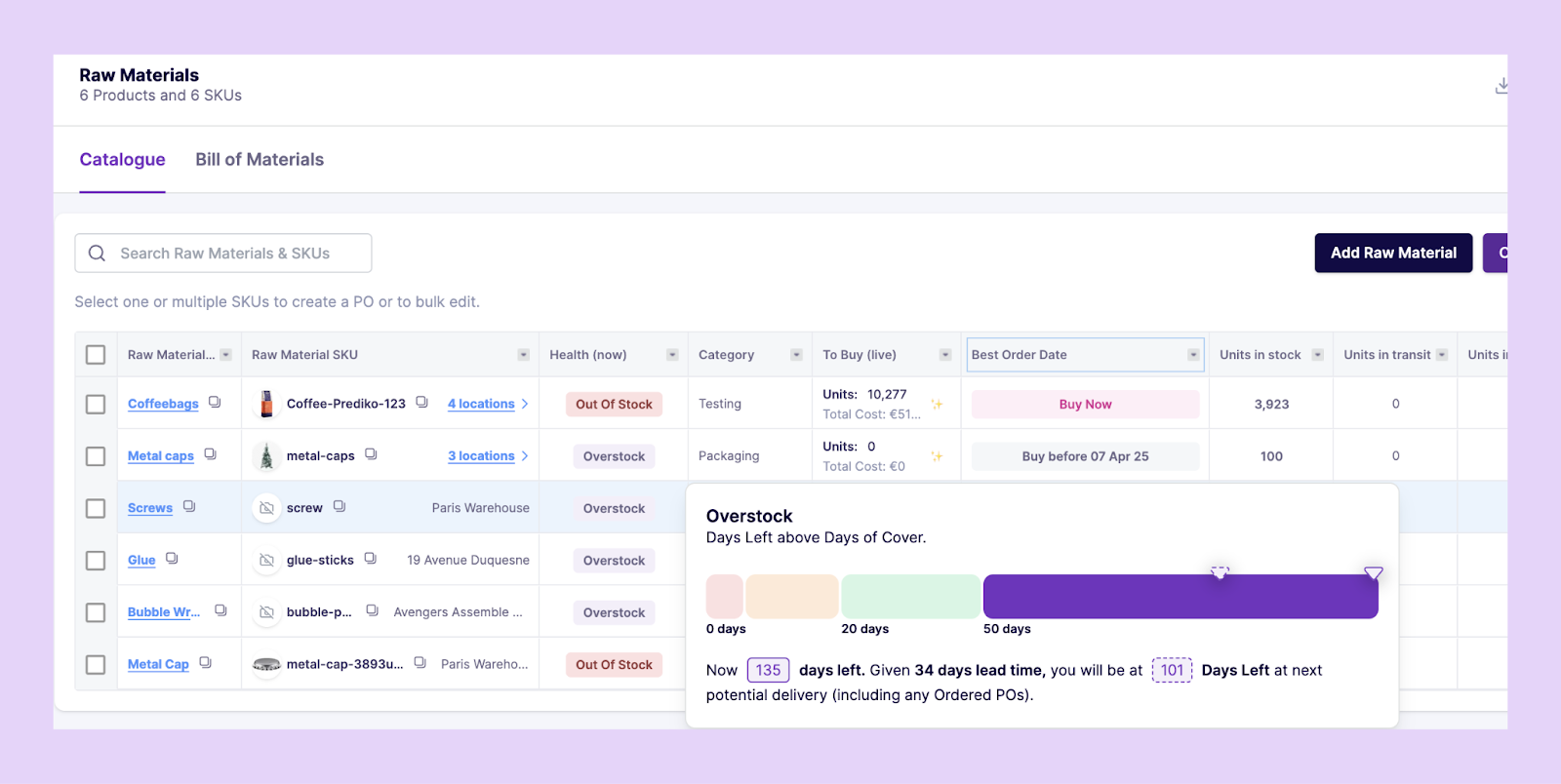
Manage raw materials alongside finished goods with ease. Prediko gives you reordering suggestions for raw materials based on finished goods demand.
You can track inventory, monitor usage, and forecast raw material needs, making it ideal for manufacturers and brands with in-house production.
5. Analytics and reports

Get access to 20+ preset reports, including COGS, dead stock, and ABC analysis, or build custom ones to track the metrics that matter most to you.
You can easily schedule reports and get low stock alerts, along with daily or weekly inventory summaries, delivered straight to your inbox.
Your turn to get one step ahead. Try Prediko free for 14 days —single app to replace all your messy spreadsheets.



.avif)



